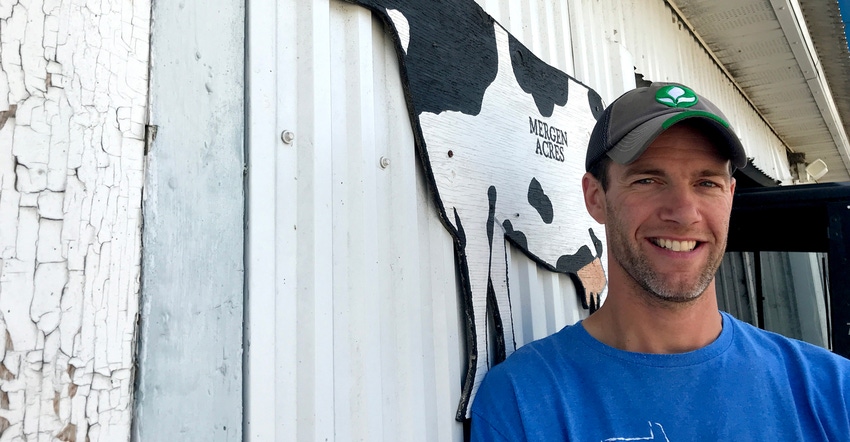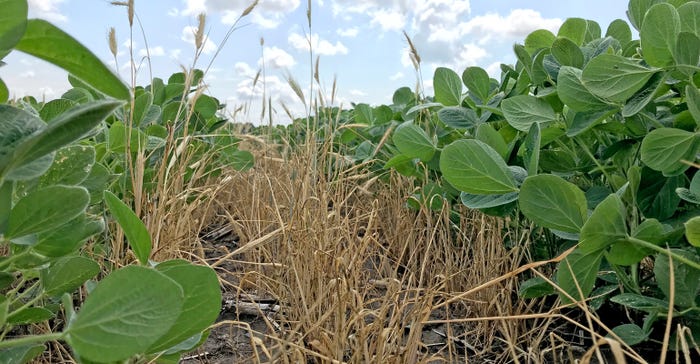July 27, 2021

Stearns County farmer Ben Mergen was among the first to sign up for a pilot project that will quantify environmental benefits of the cover crops he’s implementing on his dairy and beef operation.
Verifying the carbon sequestration and water-quality improvements that result from soil health practices will position Mergen — and others within the Sauk River watershed, one of about a dozen pilot sites across the U.S. — to sell credits on a national market.
Marketplace for soil health practices
The nonprofit Ecosystem Services Marketplace Consortium, a public-private partnership of the ag supply and value chain, is seeking buyers as it prepares for a 2022 launch. ESMC and The Nature Conservancy developed the pilot to help farmers earn additional revenue for practices that improve soil health, sequester carbon and reduce pollutant-carrying field runoff. The pilot will fine-tune testing protocols used to verify credits. The Farmer first featured this project in a story last October; see bit.ly/stearnssoilhealth.
 BEANS IN GREEN: Ben Mergen planted soybeans directly into a living oats-winter rye crop, which he later killed with a well-timed chemical application. The crop, shown here in a June 29 photo, was on pace with the conventionally tilled soybeans on his farm near Albany.
BEANS IN GREEN: Ben Mergen planted soybeans directly into a living oats-winter rye crop, which he later killed with a well-timed chemical application. The crop, shown here in a June 29 photo, was on pace with the conventionally tilled soybeans on his farm near Albany.

“Along with nitrogen-scavenging and nutrient-scavenging, keeping something living in the soil and erosion control, it’s just another aspect of cover crops that maybe will bring a profit,” Mergen says.
Mergen moved back to the farm 10 years ago from Indiana, where he’d been working for Gavilon Grain.
At the time, his father, Roger, was ready to cut back. He still helps with fieldwork and twice-daily chores. But Mergen, a fifth-generation farmer, lives on the homeplace with his wife, Alicia, and their three daughters.
The Mergens milk 50 Holsteins and raise a beef herd of 25 cow-calf pairs. They raise about 500 acres of corn, soybeans, alfalfa and an occasional spring wheat crop.
With dairy, beef, corn and soybeans, it’s exactly the sort of farm the pilot project is seeking.
Funding from the USDA’s Natural Resources Conservation Service, The Nature Conservancy and the Minnesota Department of Agriculture cover costs associated with the three-year signup period, which ends in 2022.
“Right now, the big benefit is you get to the front of the line for the cost-share programs,” says Leif Fixen, agriculture strategy manager for TNC in Minnesota, North Dakota and South Dakota.
Carbon reduction, water quality credits
The ESMC tool can be used for third-party valuation of carbon reduction or water-quality improvement within a company’s supply chain. It can also generate tradeable credits that can be sold to a company.
“The farmer will be able to market each of those credits independently,” Fixen says. “Once the marketplace is launched, you’ll be able to sell your carbon credit, you’ll be able to sell a water-quality credit — and potentially even inside of that water-quality credit you’ll be able to sell your nitrogen credit, you’ll be able to sell your phosphorus credit and you’ll be able to sell your total suspended solids credit. A lot of that is a little less-known right now, how that all will work.”
The pilot aims to enroll 50,000 acres within the Sauk River watershed, which drains to the Mississippi River. The watershed was chosen partly because the Stearns County Soil and Water Conservation District already was working with producers on All Acres for Our Water. Another pilot designed to spur conservation practices, All Acres for Our Water involves TNC and the Minnesota Land Trust.
By early summer, Dennis Fuchs, Stearns County SWCD administrator, says enrollment totaled about 500 acres. SWCD staff members contact landowners, offer technical assistance and help producers apply for reimbursements. SWCD staff also help with soil sampling, which will be repeated in five years.
“I think it’s another avenue to reach farmers looking to improve their resources. It’s also an opportunity to leverage additional financial resources for our farmers as they implement additional conservation practices,” Fuchs says.
The 50-acre enrollment on Mergen’s farm is also part of All Acres for Our Water, which centers on the Backes Lake sub-watershed.
“What we’re trying to do is clean up the water — either stop erosion of soil or runoff of nutrients. That’s where all of this will tie in, so that we can cut down on the nitrates, whether it’s in groundwater or whether it’s getting into a stream and heading down to the Mississippi and out to the Gulf,” Mergen says of the programs. “As far as benefits, besides what’s on the farm and in our pocketbook, it’ll be the environment with the cleaner water; and then the carbon capture has to do with climate change.”
Cover crops are key
Mergen first tried cover crops five years ago with a 40-acre signup through the NRCS Conservation Stewardship Program.
“You kind of got paid to try it, so there wasn’t a whole lot of risk involved, which is a nice way to start any kind of project you don’t know a whole lot about,” Mergen says.
This season, his cover crop enrollments total 90 acres. The programs in which he’s involved will generate about $11,000 in assistance.
He tried something new on the 13-acre bean field: planting green. This spring, he seeded soybeans into a living rye cover crop. Mergen says the method required closely watching the rye, which tends to take off in the spring, but a well-timed chemical application successfully killed the cover crop. The beans, planted at the same time as conventionally tilled fields, were thriving in late June.
“I’m hoping to get at least half my ground covered in cover crops, if not three-quarters,” Mergen says of his long-term goal.
His best advice to those considering soil health practices: “Start small. Don’t do more than you think you can handle in spring or fall.”
This year, Mergen further committed to soil health practices when he became a cover crop seed dealer and bought a strip-till machine.
“I’m hoping to do some custom work, maybe see if some other people want to try the strip-till,” he says, adding, “No-tilling soybeans looks like it’s working pretty well so far. We’ll see what the yield monitor says, but so far it looks like a pretty nice stand.”
Along with Stearns SWCD, project partners in Minnesota include AgCentric, Centra Sota Cooperative, the Environmental Initiative, Field to Market, the Headwaters Agriculture Sustainability Partnership, Houston Engineering, Land O’Lakes Truterra, mbold.org, Midwest Dairy, the Minnesota Milk Producers Association, Syngenta and the University of Minnesota Forever Green Initiative.
For more information, visit ESMC at ecosystemservicesmarket.org.
Wessel, from Waite Park, Minn., is an information officer with the Minnesota Board of Water and Soil Resources.
Source: BWSR, which is solely responsible for the information provided and is wholly owned by the source. Informa Business Media and all of its subsidiaries are not responsible for any of the content contained in this information asset.
You May Also Like




